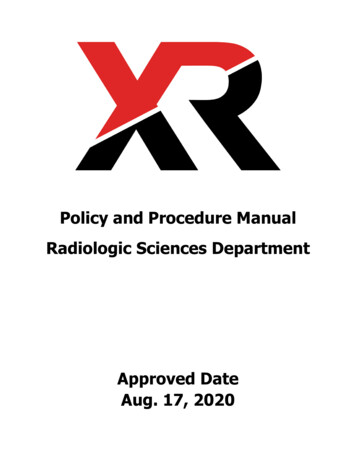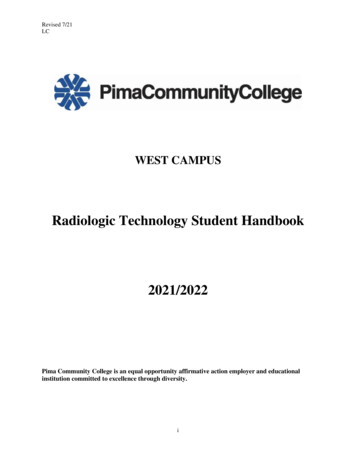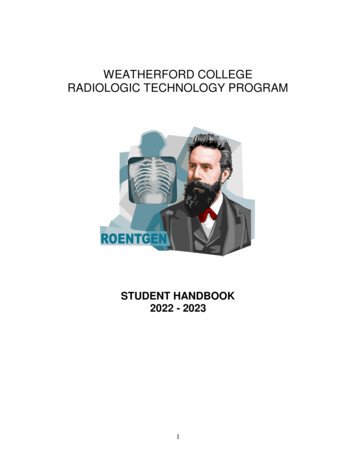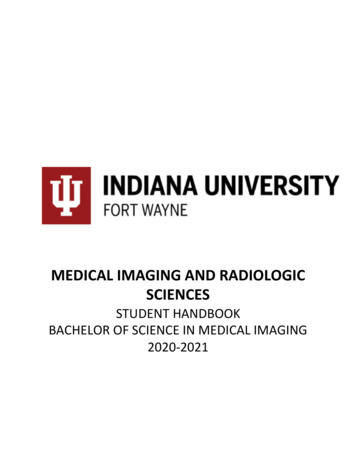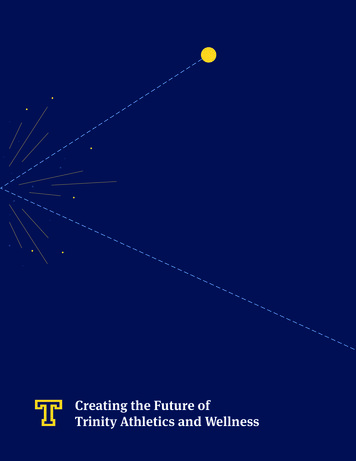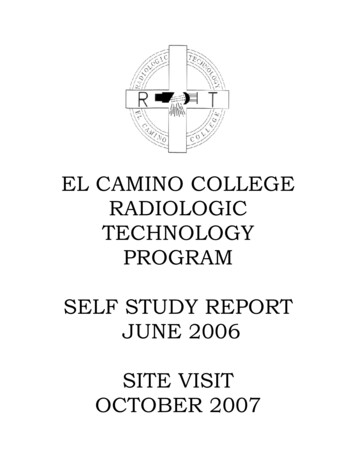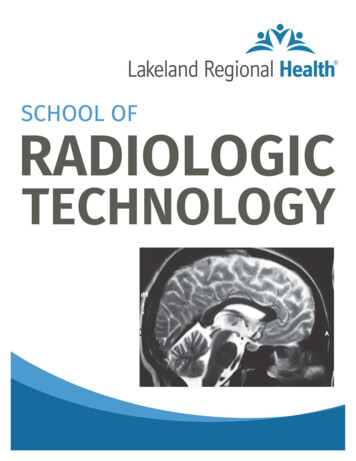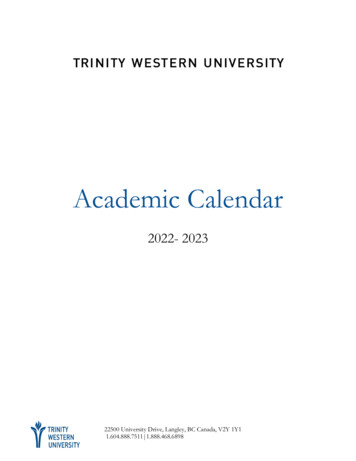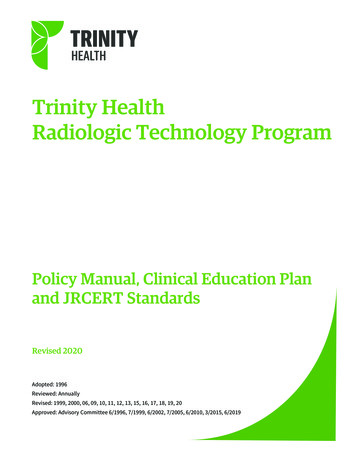
Transcription
Trinity HealthRadiologic Technology ProgramPolicy Manual, Clinical Education Planand JRCERT StandardsRevised 2020Adopted: 1996Reviewed: AnnuallyRevised: 1999, 2000, 06, 09, 10, 11, 12, 13, 15, 16, 17, 18, 19, 20Approved: Advisory Committee 6/1996, 7/1999, 6/2002, 7/2005, 6/2010, 3/2015, 6/2019
Policy and Procedure AgreementThis Manual is intended to be a description of the policies, academic processes, degree requirements andcourse offerings in effect for the 2020-2021 academic year for our program. The Trinity Health RadiologicTechnology Program reserves the right to change any of the policies and procedures described in thisPolicy Manual as deemed necessary. Students shall read the Policy Manual, shall have the opportunities toask questions and have their questions answered. Students are required to comply with the policies, rulesand regulations of the Trinity Health Radiologic Technology Program and Trinity Health. Upon completionof the Policy Manual review, the student will read and sign a form stating they received a copy of, read andhad opportunity to seek clarifications on any policies, procedures or standards. This form will become apart of the student’s permanent file.
Table of ContentsPolicy Manual IndexCareer of Radiologic Technology . . . . . . . . . . . . . . . . . . . . . . . . . . . . . . . . . . . . . . . . . . . . . . . . . . . . . . . . . . . . . . . . . .1Trinity Health . . . . . . . . . . . . . . . . . . . . . . . . . . . . . . . . . . . . . . . . . . . . . . . . . . . . . . . . . . . . . . . . . . . . . . . . . . . . . . . . . . . .1Organizational Chart . . . . . . . . . . . . . . . . . . . . . . . . . . . . . . . . . . . . . . . . . . . . . . . . . . . . . . . . . . . . . . . . . . . . . . . . . . . . .1History of Program . . . . . . . . . . . . . . . . . . . . . . . . . . . . . . . . . . . . . . . . . . . . . . . . . . . . . . . . . . . . . . . . . . . . . . . . . . . . . . .2Mission/Student Learning Outcomes . . . . . . . . . . . . . . . . . . . . . . . . . . . . . . . . . . . . . . . . . . . . . . . . . . . . . . . . . . . . . . .3Admission Requirements . . . . . . . . . . . . . . . . . . . . . . . . . . . . . . . . . . . . . . . . . . . . . . . . . . . . . . . . . . . . . . . . . . . . . . . . .6Application Process . . . . . . . . . . . . . . . . . . . . . . . . . . . . . . . . . . . . . . . . . . . . . . . . . . . . . . . . . . . . . . . . . . . . . . . . . . . . . .7Academic Scoring for admission . . . . . . . . . . . . . . . . . . . . . . . . . . . . . . . . . . . . . . . . . . . . . . . . . . . . . . . . . . . . . . . . . . .9Acceptance into the Program . . . . . . . . . . . . . . . . . . . . . . . . . . . . . . . . . . . . . . . . . . . . . . . . . . . . . . . . . . . . . . . . . . . .10Advisory Committee . . . . . . . . . . . . . . . . . . . . . . . . . . . . . . . . . . . . . . . . . . . . . . . . . . . . . . . . . . . . . . . . . . . . . . . . . . . .10Student Expenses . . . . . . . . . . . . . . . . . . . . . . . . . . . . . . . . . . . . . . . . . . . . . . . . . . . . . . . . . . . . . . . . . . . . . . . . . . . . . . .11Financial AidTuitionAffiliated UniversitiesRefundsBooksUniformProfessional OrganizationsEntrance Health ExaminationHealth Insurance . . . . . . . . . . . . . . . . . . . . . . . . . . . . . . . . . . . . . . . . . . . . . . . . . . . . . . . . . . . . . . . . . . . . . . . .12Transfer of creditsStudent ServicesProgram Schedules . . . . . . . . . . . . . . . . . . . . . . . . . . . . . . . . . . . . . . . . . . . . . . . . . . . . . . . . . . . . . . . . . . . . . . . . . . . . .13Academic Calendar . . . . . . . . . . . . . . . . . . . . . . . . . . . . . . . . . . . . . . . . . . . . . . . . . . . . . . . . . . . . . . . . . . . . . . . . . . . . .14JRCERT Clinical Sites . . . . . . . . . . . . . . . . . . . . . . . . . . . . . . . . . . . . . . . . . . . . . . . . . . . . . . . . . . . . . . . . . . . . . . . . . . . .14General Curriculum Sequence . . . . . . . . . . . . . . . . . . . . . . . . . . . . . . . . . . . . . . . . . . . . . . . . . . . . . . . . . . . . . . . . . . . .15Course Descriptions . . . . . . . . . . . . . . . . . . . . . . . . . . . . . . . . . . . . . . . . . . . . . . . . . . . . . . . . . . . . . . . . . . . . . . . . . . . .16Academic Standards . . . . . . . . . . . . . . . . . . . . . . . . . . . . . . . . . . . . . . . . . . . . . . . . . . . . . . . . . . . . . . . . . . . . . . . . . . . .21Grading Policy . . . . . . . . . . . . . . . . . . . . . . . . . . . . . . . . . . . . . . . . . . . . . . . . . . . . . . . . . . . . . . . . . . . . . . . . . . . . . . . . . .22Probation and Student Conduct Policy . . . . . . . . . . . . . . . . . . . . . . . . . . . . . . . . . . . . . . . . . . . . . . . . . . . . . . . . . . .23Dismissal/Discipline Policy . . . . . . . . . . . . . . . . . . . . . . . . . . . . . . . . . . . . . . . . . . . . . . . . . . . . . . . . . . . . . . . . . . . . . . .23Code of Ethics Policy . . . . . . . . . . . . . . . . . . . . . . . . . . . . . . . . . . . . . . . . . . . . . . . . . . . . . . . . . . . . . . . . . . . . . . . . . . . .26Total Didactic/Clinical Hours . . . . . . . . . . . . . . . . . . . . . . . . . . . . . . . . . . . . . . . . . . . . . . . . . . . . . . . . . . . . . . . . . . . . .27Vacation and Leave . . . . . . . . . . . . . . . . . . . . . . . . . . . . . . . . . . . . . . . . . . . . . . . . . . . . . . . . . . . . . . . . . . . . . . . . . . . . .28CTO/PLD . . . . . . . . . . . . . . . . . . . . . . . . . . . . . . . . . . . . . . . . . . . . . . . . . . . . . . . . . . . . . . . . . . . . . . . . . . . . . . . . . . . . . . .29Medical AppointmentsTardinessJury Duty . . . . . . . . . . . . . . . . . . . . . . . . . . . . . . . . . . . . . . . . . . . . . . . . . . . . . . . . . . . . . . . . . . . . . . . . . . . . . .31Long Term Disability . . . . . . . . . . . . . . . . . . . . . . . . . . . . . . . . . . . . . . . . . . . . . . . . . . . . . . . . . . . . . . . . .32Graduation Requirements . . . . . . . . . . . . . . . . . . . . . . . . . . . . . . . . . . . . . . . . . . . . . . . . . . . . . . . . . . . . . . . . . . . . . . .33Early Release/Delayed Release . . . . . . . . . . . . . . . . . . . . . . . . . . . . . . . . . . . . . . . . . . . . . . . . . . . . . . . . . . . . . . . . . . .34Student Records . . . . . . . . . . . . . . . . . . . . . . . . . . . . . . . . . . . . . . . . . . . . . . . . . . . . . . . . . . . . . . . . . . . . . . . . . . . . . . . .35Inclement WeatherStudent Safety Policies . . . . . . . . . . . . . . . . . . . . . . . . . . . . . . . . . . . . . . . . . . . . . . . . . . . . . . . . . . . . . . . . . . . . . . . . . .36General
ViolenceSexual Harassment . . . . . . . . . . . . . . . . . . . . . . . . . . . . . . . . . . . . . . . . . . . . . . . . . . . . . . . . . . . . . . . . . . .36Non-fraternizationDiscriminationRadiation Safety . . . . . . . . . . . . . . . . . . . . . . . . . . . . . . . . . . . . . . . . . . . . . . . . . . . . . . . . . . . . . . . . . . . . . . . . . . . . . . .38MRI . . . . . . . . . . . . . . . . . . . . . . . . . . . . . . . . . . . . . . . . . . . . . . . . . . . . . . . . . . . . . . . . . . . . . . . . . . . . . . . . . . . . . . . . . . . .39Compliance . . . . . . . . . . . . . . . . . . . . . . . . . . . . . . . . . . . . . . . . . . . . . . . . . . . . . . . . . . . . . . . . . . . . . . . . . . . . . . . . . . . .41Grievance . . . . . . . . . . . . . . . . . . . . . . . . . . . . . . . . . . . . . . . . . . . . . . . . . . . . . . . . . . . . . . . . . . . . . . . . . . . . . . . . . . . . . .43Safety Event Report . . . . . . . . . . . . . . . . . . . . . . . . . . . . . . . . . . . . . . . . . . . . . . . . . . . . . . . . . . . . . . . . . . . . . . . . . . . . .44Complaints . . . . . . . . . . . . . . . . . . . . . . . . . . . . . . . . . . . . . . . . . . . . . . . . . . . . . . . . . . . . . . . . . . . . . . . . . . . . . . . . . . . . .44Student Rights/Responsibilities . . . . . . . . . . . . . . . . . . . . . . . . . . . . . . . . . . . . . . . . . . . . . . . . . . . . . . . . . . . . . . . . . .45Health Services . . . . . . . . . . . . . . . . . . . . . . . . . . . . . . . . . . . . . . . . . . . . . . . . . . . . . . . . . . . . . . . . . . . . . . . . . . . . . . . . .46Drug Policy . . . . . . . . . . . . . . . . . . . . . . . . . . . . . . . . . . . . . . . . . . . . . . . . . . . . . . . . . . . . . . . . . . . . . . . . . . . . . . . . . . . . .47Transportation/Parking . . . . . . . . . . . . . . . . . . . . . . . . . . . . . . . . . . . . . . . . . . . . . . . . . . . . . . . . . . . . . . . . . . . . . . . . .48Professionalism . . . . . . . . . . . . . . . . . . . . . . . . . . . . . . . . . . . . . . . . . . . . . . . . . . . . . . . . . . . . . . . . . . . . . . . . . . . . . . . .48AppearanceDress codeCell Phone . . . . . . . . . . . . . . . . . . . . . . . . . . . . . . . . . . . . . . . . . . . . . . . . . . . . . . . . . . . . . . . . . . . . . . . . . . . . . . . . . . . . .50Patient Transport . . . . . . . . . . . . . . . . . . . . . . . . . . . . . . . . . . . . . . . . . . . . . . . . . . . . . . . . . . . . . . . . . . . . . . . . . . . . . . .50Student Employment . . . . . . . . . . . . . . . . . . . . . . . . . . . . . . . . . . . . . . . . . . . . . . . . . . . . . . . . . . . . . . . . . . . . . . . . . . .50Reasonable Accommodations . . . . . . . . . . . . . . . . . . . . . . . . . . . . . . . . . . . . . . . . . . . . . . . . . . . . . . . . . . . . . . . . . . .50Pregnancy Policy . . . . . . . . . . . . . . . . . . . . . . . . . . . . . . . . . . . . . . . . . . . . . . . . . . . . . . . . . . . . . . . . . . . . . . . . . . . . . . .52Communicable Disease . . . . . . . . . . . . . . . . . . . . . . . . . . . . . . . . . . . . . . . . . . . . . . . . . . . . . . . . . . . . . . . . . . . . . . . . . .53Signature Page . . . . . . . . . . . . . . . . . . . . . . . . . . . . . . . . . . . . . . . . . . . . . . . . . . . . . . . . . . . . . . . . . . . . . . . . . . . . . . . . .55Pandemic/Unusual Safety Situations . . . . . . . . . . . . . . . . . . . . . . . . . . . . . . . . . . . . . . . . . . . . . . . . . . . . . . . . . . . . .54Clinical Education PlanIntroduction . . . . . . . . . . . . . . . . . . . . . . . . . . . . . . . . . . . . . . . . . . . . . . . . . . . . . . . . . . . . . . . . . . . . . . . . . . . . . . . . . . . .56Glossary . . . . . . . . . . . . . . . . . . . . . . . . . . . . . . . . . . . . . . . . . . . . . . . . . . . . . . . . . . . . . . . . . . . . . . . . . . . . . . . . . . . . . . .57Clinical Education Plan . . . . . . . . . . . . . . . . . . . . . . . . . . . . . . . . . . . . . . . . . . . . . . . . . . . . . . . . . . . . . . . . . . . . . . . . . .58Integration Flow Chart . . . . . . . . . . . . . . . . . . . . . . . . . . . . . . . . . . . . . . . . . . . . . . . . . . . . . . . . . . . . . . . . . . . . . . . . . .59Clinical Testing/Student Learning Outcome . . . . . . . . . . . . . . . . . . . . . . . . . . . . . . . . . . . . . . . . . . . . . . . . . . . . . . .60Clinical Grading/Student Learning Outcome . . . . . . . . . . . . . . . . . . . . . . . . . . . . . . . . . . . . . . . . . . . . . . . . . . . . . . .61Clinical Performance Evaluation . . . . . . . . . . . . . . . . . . . . . . . . . . . . . . . . . . . . . . . . . . . . . . . . . . . . . . . . . . . . . . . . .66Final Competency Testing . . . . . . . . . . . . . . . . . . . . . . . . . . . . . . . . . . . . . . . . . . . . . . . . . . . . . . . . . . . . . . . . . . . . . . .68Student Supervision Policy . . . . . . . . . . . . . . . . . . . . . . . . . . . . . . . . . . . . . . . . . . . . . . . . . . . . . . . . . . . . . . . . . . . . . .70Clinical site rooms/number of techs . . . . . . . . . . . . . . . . . . . . . . . . . . . . . . . . . . . . . . . . . . . . . . . . . . . . . . . . . . . . . .72Clinical Master Schedule and Clinical Rotation Locations . . . . . . . . . . . . . . . . . . . . . . . . . . . . . . . . . . . . . . . . . . .73Trajecsys . . . . . . . . . . . . . . . . . . . . . . . . . . . . . . . . . . . . . . . . . . . . . . . . . . . . . . . . . . . . . . . . . . . . . . . . . . . . . . . . . . . . . . .74Clinical Ed Plan Evenings/Weekends . . . . . . . . . . . . . . . . . . . . . . . . . . . . . . . . . . . . . . . . . . . . . . . . . . . . . . . . . . . . . .75Advanced Radiographic and Medical Imaging Clinical Rotations . . . . . . . . . . . . . . . . . . . . . . . . . . . . . . . . . . . . .76General Clinical Rules . . . . . . . . . . . . . . . . . . . . . . . . . . . . . . . . . . . . . . . . . . . . . . . . . . . . . . . . . . . . . . . . . . . . . . . . . . .78Appendix A – JRCERT Standards (2014)
Career of Radiologic TechnologyRadiologic Technology is a science combining advanced technology and human compassion. RadiologicTechnologists (radiographers) use their knowledge of physics and human anatomy to create permanent medicalimages to diagnose disease. The radiologic technologist is qualified to provide patient services using various typesof imaging equipment. The radiologic technologist works under the direction of a Radiologist — a medical physicianwith extensive training in performing radiologic procedures and interpreting medical images. This is a professionwhich requires a dependable personality with a mature, caring nature and an ability to exercise independentjudgment. For additional information on career opportunities, explore the ASRT website diologic-technologyTrinity HealthFounded in 1922, Trinity Health is a not-for-profit, integrated healthcare system serving North Dakota and EasternMontana. With three hospitals, 15 clinics, two nursing homes and a regional eyecare network, Trinity Health providescomprehensive, leading-edge care to Minot and the surrounding region.Trinity’s primary hospital campus is accredited by The Joint Commission (TJC) and the region’s only Level IITrauma Center. Trinity offers a state-of-art cancer care center, comprehensive heart services, including open heartsurgery, and advanced neurosurgical care.Trinity Health is staffed by more than 2,900 physicians, nurses and other healthcare professionals. Trinity MedicalGroup is a regional network of more than 150 physicians and allied health professionals representing over 40primary care and specialty services.A teaching hospital, Trinity sponsors the University of North Dakota School of Medicine residency program.Organizational Chart1
Trinity Health Radiologic Technology ProgramThe school of radiologic technology has an excellent reputation of graduating professional RadiologicTechnologists (Radiographers) of high academic excellence and above average entry level technical skills. Ourgraduates typically score above the 90th percentile on the American Registry of Radiologic Technology (ARRT)national registry exam to become certified Radiographers.The school is a two-year certificate program accredited by the Joint Review Commission on Education inRadiologic Technology (JRCERT), 20 N. Wacker Drive, Suite 2850, Chicago, IL 60606-3182, 312-704-5300, (website:www.jrcert.org) (e-mail: jrcert@mail.idt.net). For more information contact the Program Director at phone number:701-857-2316 or mailing address: Trinity Health Radiologic Technology Program, PO Box 5020, Minot, ND 587025020. Additional Information can be found on the program website, trinityhealth.org/radiology schoolThe school accepts up to 6 students each year. Classes begin in June and concludes with graduation in May. The23 month Program operates on a schedule of three semesters per year. The school week runs from Sunday throughSaturday. The student will complete six consecutive semesters during their internship, including a limited number ofweekend and evening clinical rotations. Time spent in weekend and evening assignment rotations will not exceed25% of the students total clinical clock hours.The Trinity Health Radiologic Technology Program is an outcome-based educational program with the primaryfocus on competency achieved through a mastery learning system. Integration of classroom and clinical education isalso an important element to the success of the school and its graduates. The student benefits from hospital andclinic radiology patient care environments, state-of-art imaging equipment, highly skilled staff of RegisteredTechnologists, a small enrollment and educators with years of clinical and teaching experience. The clinicalexperience is designed to maximize patient contact in performance of radiography procedures. All students aresupervised while in their clinical training by ARRT registered and JRCERT approved Clinical Instructors. Uponcompletion of this program, graduates will be eligible to take the ARRT registry exam and upon successful completion,be recognized as professional, competent entry level Radiographers.2
Mission Statement, Goals and Student Learning OutcomesMISSION STATEMENT:The mission of the Trinity Health Radiologic Technology Program is to provide a comprehensive, quality education inthe art and science of radiologic technology. The program strives to prepare service-oriented, knowledgeable entrylevel radiographers who demonstrate qualities of excellence in critical thinking, professionalism, patient care, safetyand ethical behavior in serving their patients, healthcare community and the profession.GOALS and STUDENT LEARNING OUTCOMES (SLO’s):Goal 1: To graduate students who possess effective verbal and written communication skills.SLO 1.1: Students will demonstrate effective patient communication skills.SLO 1.2: Students will demonstrate effective written and verbal communication skillsGoal 2: To graduate students who can apply critical thinking skills to professional practice.SLO 2.1: Students will exhibit necessary critical thinking skills in the positioning and performance ofpatient exams.SLO 2.2: Students will demonstrate the ability to critically evaluate completed radiographs.Goal 3: To graduate students who are clinically competent entry level radiographers.SLO 3.1: Students will produce images exhibiting accurate positioning and acceptable radiographic quality.SLO 3.2: To graduate students with effective radiation protection practices for self, patients andhealthcare team.Goal 4: To graduate students who possess ethical and professional behaviors necessary for an entry levelradiographer.SLO 4.1: Students will demonstrate professionalism and ethical behavior.SLO 4.2: Students will demonstrate professionalism with the healthcare team.ACHIEVEMENT OF GOALS:To accomplish these goals we believe correlation of didactic and clinical education must exist. We believe thatthrough a mastery and competency based education, the student will learn to function decisively, independentlyand correctly.The following COMPETENCIES have been established as essential and minimum for the student to functionadequately in a modern health care system. These competencies also serve a multifold purpose as a workingstructural model for our program.This includes but is not limited to the following purposes:1. serve as a curriculum guide2. serve as a guideline to develop performance indicators for clinical and didactic courses3. serve as criteria for measuring student learning outcomes, through testing and gradingCompetency #1Apply knowledge of the principles of x-ray production and appropriate usage of radiation production equipment toprovide safety for the patient, themselves and other health care professionals. Explain x-ray production. Identify the properties of x-ray. Distinguish between electromagnetic radiation and particulate radiation. Define types of radioactivity. Utilize and understand the fundamental units of radiation. Explain x-ray interactions with matter. Explain the biologic effects of radiation to the human body.3
Explain the necessity and importance of radiation protection for the patient, self and others. Identify factors that will result in an increase or decrease in radiation exposure to patient and self. Apply methods of radiation protection in the clinical setting which will result in minimal exposure to self,patient and others while preserving the quality of radiographic exam. State the National Council on Radiation Protection guidelines and dose equivalence limits. Demonstrate proper and safe manipulation of x-ray equipment in the clinical setting. Apply knowledge of electrodynamics to the x-ray circuit.Competency #2Apply knowledge of anatomy, physiology, pathology and positioning to accurately demonstrate structures forradiologic exams. Define and utilize medical terminology. Identify the anatomy of the body systems. Understand physiology as it relates to radiography. Define pathologic conditions and identify them radiographically. Understand and utilize radiographic positioning terminology and landmarks. Explain and demonstrate the radiographic positions and projections necessary to demonstrate and evaluatebody anatomy and pathology, radiographically. Exercise discretion and judgement, in clinical situations, to utilize alternate positioning and examinationmethods to better demonstrate anatomic structures when limited by the condition of patient. Make appropriate adjustments in positioning and procedures to perform pediatric examinations. Identify radiologic contrast medias, their usages and indications. Select, prepare, assist and administer appropriate contrast media to patients.Competency #3Determine proper exposure factors which will achieve optimum radiographic quality. Apply knowledge of mathematical formulas to calculate and adjust exposure factors to compensate forequipment and technique changes. Apply knowledge to determine the effects of altering quality and quantity of the x-ray beam on theradiographic image. Understand the primary and secondary influences on radiographic quality and how they alter radiographicquality. Differentiate between additive and destructive pathologies and how to vary exposure techniqueappropriately. Apply knowledge and understanding of how body habitus affects exposure techniques and equipment utilized. Adjust necessary exposure factors for pediatric radiography. Understand and utilize proper exposure factors for patient protection.Competency #4Examine radiographic images for the purpose of making judgmental decisions concerning positioning, technicalfactors, pathology factors and radiation protection aspects. Utilize evaluation criteria to identify if radiographic image includes all anatomical structures necessary. Utilize evaluation criteria to determine between acceptable and unacceptable patient positioning todemonstrate necessary anatomy. Discriminate between acceptable and unacceptable exposure technique and exposure indices onradiographic image. Understand and demonstrate the ability to make the proper changes required to successfully repeat anunsatisfactory image. Identify proper legal information on a radiographic image (markers, name, date, etc.) Perform appropriate image manipulation techniques before transferring and saving the images.4
Competency #5Provide appropriate patient care. Understand the importance of providing for the physical and psychological needs of patients in all age groupsand various ethnic backgrounds. Understand the importance of, and provide for, proper patient/technologist communication. Provide appropriate patient education. Demonstrate an understanding of the functions of the various specialty areas of radiology. Understand and practice the Code of Ethics for the Profession of Radiologic Technology and the “Principles ofProfessional conduct for the Radiologic Technologist”. Demonstrate proper body mechanics for maximum patient safety and personal safety. Apply and demonstrate the consistent use of Standard Precautions, on all patients. Apply and demonstrate the principles of aseptic technique. Apply and demonstrate the principles of sterile technique. Recognize emergency situations and demonstrate appropriate and necessary response. Become CPR certified.Competency #6Understand and apply human interactions in the medical domain. Understand the organizational structure of the hospital, clinical sites and department of radiology. Understand the function of a radiographer/radiologic technologist in the medical domain. Apply principles of appropriate communications in interactions with all personnel.5
Admission Process RequirementsThe Trinity Health Radiologic Technology Program (“the Program”) subscribes to the principles and laws ofthe state of North Dakota and the federal government pertaining to civil rights and equal opportunity. TheProgram’s policies prohibit discrimination on the basis of race, gender, religion, age, color, creed, national orethnic origin, marital status or disability in the recruitment and admission of students and the employment offaculty, staff and students and in the operation of all program activities and services. Evidence of practice whichare inconsistent with this policy should be reported to the Program Director and/or Human Resource Director.The Joint Review Committee on Education in Radiologic Technology (JRCERT) has approved the Program for up to6 students per year. However, the Program reserves the right to admit only those applicants who meet establishedminimum requirements for age, education, physical and personal skills. The Program does not accept transferstudents from other clinical radiography programs, accommodate part time students or offer advance placement.The Program does accept transfer credits for college coursework to assess whether an applicant has fulfilled theprerequisites for admission. Please note that if accepted into the Program, a criminal background check will beconducted on the student as part of processing the student into Trinity Health’s human resource system.MINIMUM REQUIREMENTSAge:Applicants must be at least 18 years of age reflective of the National Council on RadiationProtection and Measurements (NCRP) effective radiation dose limits regarding occupationalexposure in persons younger than 18.Education:The American Registry in Radiologic Technology (ARRT) is the only certifying agency in theUnited States offering credentials in medical imaging and requires candidates wishing tobecome a Registered Technologist (R.T.) by taking the ARRT radiography exam only if they1) possess at least an associate degree, and2) complete an ARRT-approved clinical educational program.In accordance with this, Program applicants must demonstrate evidence of:1) having earned a completed associate or baccalaureate degree; or2) current enrollment in a degree program that will earn the applicant an associate orbaccalaureate degree before beginning the Program.Accordingly, the satisfactory completion of the following post-secondary courses are required in order to beconsidered for admission to the Program to earn a clinical certificate in radiography:The Program’s Prerequisite Post-Secondary Courses 1 semester advanced level math (College Algebra, Precalculus, or Statistics) 2 semesters/1 full year of Anatomy and Physiology 1 semester of Physics 1 semester of Medical Terminology 1 semester of social/behavioral science course (Psychology, Sociology, Ethics) 1 semester of Oral Communication/Speech 1 semester of English CompositionGPA:The applicant must have a minimum cumulative college GPA of 2.75 at the time of application.Technical:Applicants must possess the following skills to participate in the Program and meet thephysical demands of a radiologic technologist: Fine and gross motor coordination to respond promptly and manipulate equipment Verbal and written communication skills to effectively communicate in English Hearing skills to assess patient needs and communicate effectively with other healthcareteam members Visual acuity to observe patients, manipulate equipment and evaluate radiographic image quality Ability to accomplish moderate lifting at a minimum of thirty pounds to ensure patient safety6
Satisfactory intellectual and emotional functions to exercise independent judgement anddiscretion in the safe technical performance of medical imaging proceduresThese specifications will be documented by the applicant during the application process. All applicantsaccepted into the Program are also required to present documentation that they possess these physicalrequirements by a Licensed Independent Practitioner on a Physical Fitness form provided by the school.Personal:Applicants must be of good moral and ethical character to include ability to: Reason and exercise good independent judgement Exhibit responsible, accountable and professional behaviors Work under stressful conditions Independently organize a work plan and meet deadlines Communicate effectively with patients and healthcare team members Exhibit professional discretion with confidential information Attest to integrity of academic performanceThese personal requirements will be assessed by application documents, personal references and thepersonal interview. Additionally, the American Registry of Radiologic Technologists (ARRT) requires allapplicants for certification to affirm that they have been and remain in compliance with the Code of Ethics,Rules of Ethics as spelled out in the Standards of Ethics. The ARRT establishes and enforces Rules of Ethicsthat require all applicants for certification to be of good moral character. Generally, the conviction of a crimeor felony involving moral turpitude may indicate lack of moral character and render the person ineligible totake the certification exam. Violations of academic honor codes and suspension or dismissal from aneducational program may also render an applicant ineligible to take the ARRT certification e
Trinity offers a state-of-art cancer care center, comprehensive heart services, including open heart surgery, and advanced neurosurgical care. Trinity Health is staffed by more than 2,900 physicians, nurses and other healthcare professionals. Trinity Medical Group is a regional network of more than 150 physicians and allied health professionals .

